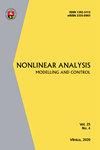Effects of Joule heating, thermal radiation on MHD pulsating flow of a couple stress hybrid nanofluid in a permeable channel
IF 2
3区 数学
Q1 MATHEMATICS, APPLIED
引用次数: 7
Abstract
The current work deals with the pulsatile hydromagnetic flow of blood-based couple stress hybrid nanofluid in a porous channel. For hybrid nanofluid, the fusion of gold (Au) and copper oxide (CuO) nanoparticles are suspended to the blood (base fluid). In this model, the employment of viscous dissipation, radiative heat, and Ohmic heating is incorporated. The governing flow equations (set of partial differential equations) are modernized to set of ordinary differential equations by using the perturbation technique. The nondimensional governing equations are solved by adopting the shooting procedure with the help of the Runge–Kutta fourth-order approach. Temperature distributions of hybrid nanofluid and conventional mono nanofluids are portrayed via pictorial results to claim that the hybrid nanofluid has better temperature distribution than mono nanofluids. Temperature is raising for the magnifying viscous dissipation, whereas the reverse behavior can be found with a rise in couple stress parameter. The heat transfer rate is getting high for the higher values of the Eckert number, and the same behavior is noticed with the uplifting magnetic field.焦耳加热和热辐射对可渗透通道中耦合应力混合纳米流体MHD脉动流的影响
目前的工作涉及基于血液的耦合应力混合纳米流体在多孔通道中的脉动流磁流动。对于混合纳米流体,金(Au)和氧化铜(CuO)纳米颗粒的融合物悬浮在血液中(基础流体)。在这个模型中,考虑了粘性耗散、辐射热和欧姆加热。利用摄动技术将控制流方程组(偏微分方程组)更新为常微分方程组。在Runge–Kutta四阶方法的帮助下,采用射击程序求解无量纲控制方程。通过图示结果描绘了混合纳米流体和传统单纳米流体的温度分布,以声称混合纳米流体比单纳米流体具有更好的温度分布。温度随着粘性耗散的增大而升高,而随着耦合应力参数的增加,可以发现相反的行为。Eckert数越高,传热率越高,并且在上升磁场中也注意到了同样的行为。
本文章由计算机程序翻译,如有差异,请以英文原文为准。
求助全文
约1分钟内获得全文
求助全文
来源期刊

Nonlinear Analysis-Modelling and Control
MATHEMATICS, APPLIED-MATHEMATICS, INTERDISCIPLINARY APPLICATIONS
CiteScore
3.80
自引率
10.00%
发文量
63
审稿时长
9.6 months
期刊介绍:
The scope of the journal is to provide a multidisciplinary forum for scientists, researchers and engineers involved in research and design of nonlinear processes and phenomena, including the nonlinear modelling of phenomena of the nature. The journal accepts contributions on nonlinear phenomena and processes in any field of science and technology.
The aims of the journal are: to provide a presentation of theoretical results and applications; to cover research results of multidisciplinary interest; to provide fast publishing of quality papers by extensive work of editors and referees; to provide an early access to the information by presenting the complete papers on Internet.
 求助内容:
求助内容: 应助结果提醒方式:
应助结果提醒方式:


